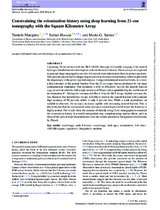| dc.contributor.author | Mangena, Tumelo | |
| dc.contributor.author | Hassan, Sultan | |
| dc.contributor.author | Santos, Mario G. | |
| dc.date.accessioned | 2021-02-11T07:32:37Z | |
| dc.date.available | 2021-02-11T07:32:37Z | |
| dc.date.issued | 2020 | |
| dc.identifier.citation | Mangena, T. et al. (2020). Constraining the reionization history using deep learning from 21-cm tomography with the Square Kilometre Array. Monthly Notices of the Royal Astronomical Society, 494(1), 600–606 | en_US |
| dc.identifier.issn | 1365-2966 | |
| dc.identifier.uri | https://doi.org/10.1093/mnras/staa750 | |
| dc.identifier.uri | http://hdl.handle.net/10566/5902 | |
| dc.description.abstract | Upcoming 21-cm surveys with the SKA1-LOW telescope will enable imaging of the neutral hydrogen distribution on cosmological scales in the early Universe. These surveys are expected to generate huge imaging data sets that will encode more information than the power spectrum. This provides an alternative unique way to constrain the reionization history, which might break the degeneracy in the power spectral analysis. Using convolutional neural networks, we create a fast estimator of the neutral fraction from the 21-cm maps that are produced by our large seminumerical simulation. Our estimator is able to efficiently recover the neutral fraction (xHI) at several redshifts with a high accuracy of 99 per cent as quantified by the coefficient of determination R2. | en_US |
| dc.language.iso | en | en_US |
| dc.publisher | Oxford University Press | en_US |
| dc.subject | Cosmology | en_US |
| dc.subject | Dark ages | en_US |
| dc.subject | Intergalactic medium | en_US |
| dc.subject | ISM:HII regions | en_US |
| dc.subject | Reionization | en_US |
| dc.subject | First stars | en_US |
| dc.title | Constraining the reionization history using deep learning from 21-cm tomography with the Square Kilometre Array | en_US |
| dc.type | Article | en_US |

